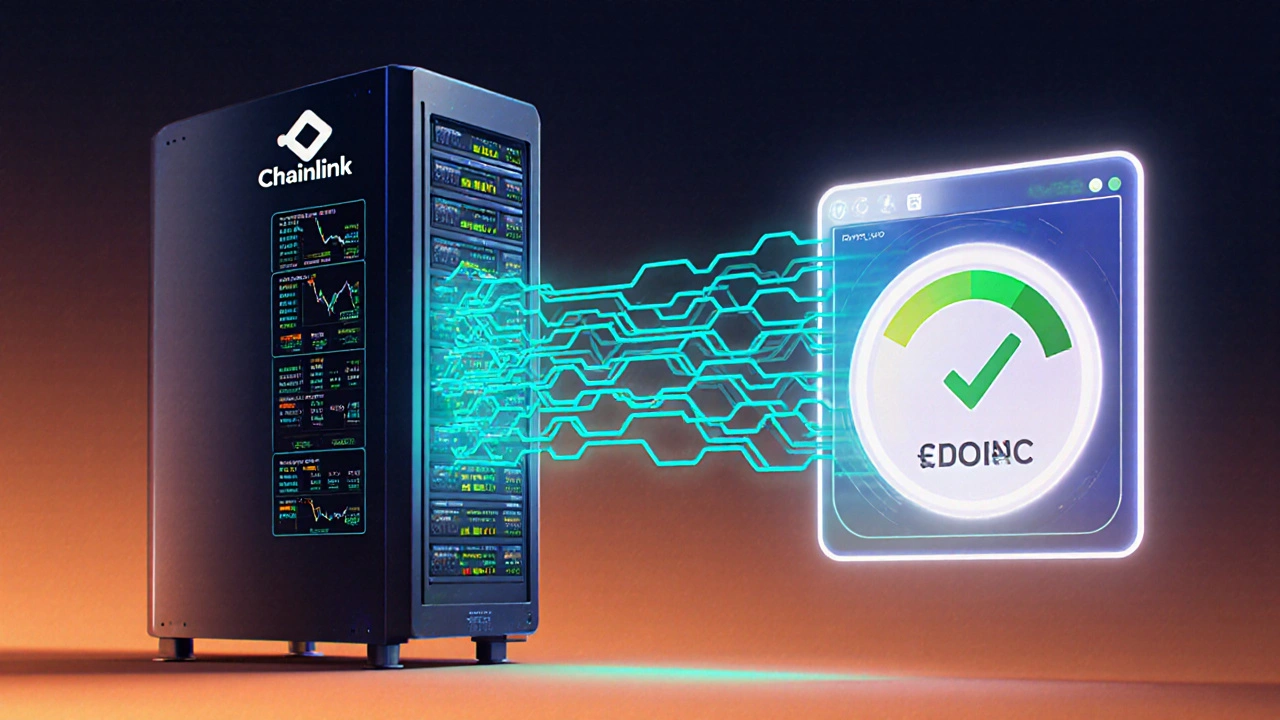How DeFi Insurance Works: A Simple Guide for Beginners

When you hear DeFi Insurance is a decentralized risk‑protection service that uses smart contracts to cover losses in blockchain protocols, you might wonder if it’s just hype or a real safety net. The short answer: it’s a growing layer of protection that works very differently from traditional insurance, but the core idea-collecting premiums and paying out claims-remains the same.
What Exactly Is DeFi Insurance?
In the world of Smart contracts self‑executing code that runs on blockchains without intermediaries, any bug, hack or market crash can wipe out funds in seconds. DeFi insurance protocols pool capital from users, lock it in a smart contract, and use that pool to reimburse victims when predefined events occur. Think of it as a mutual aid club run by code.
Key Building Blocks
Three technical pieces keep the system humming:
- Oracle services - Oracles off‑chain data providers that feed real‑world events into smart contracts tell the contract whether a loss event has happened (e.g., a smart‑contract exploit).
- Risk pool - The collective capital that backs all policies. Users stake assets into the pool and earn a share of the premiums.
- Governance token - Most protocols issue a token that lets stakers vote on new cover products, claim approvals, and fund allocations.
How Premiums Are Set and Paid
Premiums aren’t guessed; they’re calculated using actuarial models that consider historical loss rates, protocol security scores, and market volatility. When you buy a cover for, say, a yield farm on Aave a leading DeFi lending platform, you pay the premium in the protocol’s native token (often USDC a stablecoin pegged to the US dollar). The payment is locked in the risk pool for the coverage period, typically 30 or 90 days.
Claim Process in Practice
When a covered event occurs, the claimant files a request through the protocol’s UI. The Oracle checks the external data (e.g., an exploit hash on Etherscan). If the data matches the policy’s trigger conditions, the smart contract automatically releases the payout to the claimant’s wallet. No human underwriter needed, no paperwork, and the whole flow can happen in under a minute.

Major DeFi Insurance Protocols
Below are three of the most widely used platforms as of 2025. Each follows the same blueprint but differs in capital model and coverage focus.
| Protocol | Launch Year | Coverage Types | Capital Model | Notable Clients |
|---|---|---|---|---|
| Nexus Mutual | 2019 | Smart‑contract bugs, stablecoin de‑peg, custodial loss | Member‑staked capital (NXM token) | Yearn, Curve, Badger DAO |
| Cover Protocol | 2020 | Yield‑farm hacks, liquidation events | Liquidity‑provider pools (COVER token) | Sushiswap, Alpha Homora |
| InsurAce | 2021 | Protocol‑specific and portfolio‑wide policies | Hybrid (staking + LP rewards) | Polygon, Terra Classic (pre‑collapse) |
Benefits Over Traditional Insurance
- Speed: Claims settle in minutes, not weeks.
- Transparency: All rules are on‑chain; anyone can audit premium formulas.
- Access: Anyone with a crypto wallet can buy coverage, regardless of geography.
- Cost: Operating overhead is low because there’s no need for actuarial staff or legal teams.
Risks You Should Watch Out For
DeFi insurance isn’t a free lunch. Here are the main downsides:
- Smart‑contract risk: The insurance contract itself could be vulnerable.
- Capital adequacy: If many large claims hit at once, the pool may run dry.
- Oracle manipulation: Bad data feeds can trigger false payouts or deny legitimate ones.
- Regulatory uncertainty: Some jurisdictions may treat these protocols as unlicensed insurers.

Step‑By‑Step: Getting Covered in 2025
Follow these actions to secure a policy for a yield farm you plan to use:
- Identify the protocol you need protection for (e.g., Yield Guild Games a play‑to‑earn NFT liquidity guild).
- Visit a trusted insurance marketplace like the Nexus Mutual UI.
- Select the coverage amount and period. The platform will show the premium in USDC.
- Approve the USDC transfer from your wallet. The amount moves into the risk pool.
- Receive a policy token (NFT) that proves you own the cover.
- Store the token in a secure wallet. If a covered event occurs, use the UI to submit a claim.
Tips to Maximize Your Protection
- Diversify across multiple providers; no single pool can cover all worst‑case scenarios.
- Keep an eye on the Liquidity provider participants who supply assets to the risk pool health metrics-most dashboards show a capital‑to‑risk ratio.
- Prefer protocols that use decentralized oracles (e.g., Chainlink) rather than centralized feeds.
- Read community governance proposals; they reveal upcoming changes to coverage terms.
Future Outlook: Where DeFi Insurance Is Heading
By late 2025, insurers are experimenting with parametric covers that automatically trigger on price‑oracle thresholds, and with reinsurance layers built on other blockchains. Expect more traditional insurers to partner with DeFi protocols, bringing capital and regulatory compliance into the mix. For users, that means broader options and potentially lower premiums as the market matures.
Quick Checklist
- Understand the coverage trigger (smart‑contract exploit, stablecoin de‑peg, etc.).
- Verify the oracle source and its decentralization level.
- Check the risk pool's capital adequacy ratio (aim for >150%).
- Keep your policy token secure; it’s your proof of coverage.
- Stay updated on governance votes that could alter claim rules.
How does DeFi insurance differ from traditional insurance?
Traditional insurance relies on centralized underwriters, paper contracts, and lengthy claim reviews. DeFi insurance automates premium collection, risk pooling, and payouts through smart contracts, delivering instant settlements and global access.
Can I claim a payout if the oracle feeds wrong data?
If the oracle is compromised, the claim may be rejected because the contract sees the trigger as false. That’s why reputable protocols use decentralized oracle networks like Chainlink, which aggregate multiple data sources to reduce manipulation risk.
Do I need to hold the protocol’s governance token to buy coverage?
Not always. Some platforms let you pay premiums in stablecoins, while others require staking the native token (e.g., NXM for Nexus Mutual). Check each protocol’s payment options before you start.
What happen if the risk pool runs out of funds?
If a massive attack hits multiple covered protocols simultaneously, the pool can be depleted, leaving later claimants uncovered. Some projects mitigate this by buying reinsurance from other DeFi insurers or by adding a capital reserve.
Is DeFi insurance legal in my country?
Regulatory treatment varies. In the EU, some protocols are considered insurance intermediaries and may need licensing. Always consult local regulations before allocating large sums to a decentralized pool.
Thank you for laying out the fundamentals of DeFi insurance in such a clear manner. The breakdown of oracles, risk pools, and governance tokens helps newcomers grasp the moving parts without feeling overwhelmed. I appreciate the emphasis on capital adequacy ratios, as that is often the hidden metric that determines whether a protocol can survive a large‑scale attack. Your step‑by‑step guide for acquiring coverage is especially useful for users who are still navigating wallet approvals. Overall, this article strikes a good balance between technical depth and accessibility.
DeFi insurance isn’t a gimmick; it’s a direct response to smart‑contract vulnerabilities. The premium models are already calibrated against on‑chain loss data. Anything less is just speculation.
Honestly, the biggest mistake people make is assuming these protocols are risk‑free just because they’re decentralized. You still need to audit the oracle feed and check the liquidity depth before you stake any capital. I’ve seen pools evaporate overnight when a single exploit triggers a cascade of claims. That’s why diversifying across Nexus Mutual, Cover Protocol, and InsurAce makes sense. Think of it like not putting all your crypto in one savings account.
Sure, because trusting a code‑only system is always the safest bet. If the oracle decides to take a coffee break, you’re just out of luck.
DeFi insurance can give you quick payouts without paperwork.
Oh, absolutely, nothing says “peace of mind” like handing your funds to a bunch of anonymous token holders. At least the UI looks sleek, right? And if the claim gets denied, you can always enjoy the comforting glow of your dashboard. It’s practically a spa day for your portfolio.
What a refreshing dive into the brave new world of crypto protection! Your checklist shines like a lighthouse for anyone lost in the fog of DeFi terminology. I love how you highlighted the importance of decentralized oracles-without them, the whole system would be as shaky as a house of cards. The part about reinsurance layers feels like a plot twist in a thriller novel, adding depth to an otherwise technical story. Your tips on diversifying across providers are pure gold, especially for risk‑averse adventurers. Keep the vivid explanations coming; they make even the most complex concepts feel like a casual conversation over coffee.
First off, great job pulling together all the moving parts of DeFi insurance into one place. The way you described oracle integration really hits the nail on the head-if the data feed is compromised, the whole claim logic collapses. One thing I’d add is that many protocols now run multiple oracle networks in parallel, not just Chainlink, to mitigate single‑point failures. For instance, some projects blend Band Protocol and API3 data streams before reaching a consensus. This adds a layer of redundancy that can protect against feed manipulation. Speaking of redundancy, make sure you monitor the liquidity depth of the risk pool; a shallow pool can get drained after a single large exploit. You can check this on the protocol’s analytics dashboard, where they display the capital‑to‑risk ratio in real time. If you notice the ratio dipping below the recommended 150 %, it might be time to either add more capital or look for an alternative cover. Another tip is to keep an eye on governance proposals-many upgrades that affect claim criteria are decided by token holders. A proposal that changes the definition of a “covered event” could either broaden or narrow your protection without you realizing it. Also, don’t forget about reinsurance. Some DeFi insurers buy cover from traditional reinsurers or from other DeFi protocols to bolster their reserves. This practice can act as a safety net for extreme tail‑risk events. Lastly, always store your policy NFT in a hardware wallet if possible; losing the token means losing proof of coverage. By following these best practices, you can turn DeFi insurance from a novelty into a robust part of your risk‑management strategy. Hope this adds some extra clarity to your already solid guide.
It is truly commendable that we now have insurance mechanisms that can settle claims in minutes rather than weeks. One might even argue that the speed alone justifies the entire industry, despite occasional oracle hiccups. The transparency afforded by on‑chain premium formulas certainly eliminates the need for a convoluted legal department. Yet, as we celebrate these advancements, we must not ignore the lingering risk that a single smart‑contract flaw could jeopardize the whole pool. In short, while the promise is alluring, the execution still demands vigilant oversight.
Picture this: you’ve just earned a sweet yield on a new farm, and bam-a hack siphons off the liquidity in seconds. The panic is real, but DeFi insurance swoops in like a superhero, flashing an instant payout right before your eyes. The drama of watching the claim auto‑execute is almost as exhilarating as the original trade. Still, the real hero is the decentralized oracle that whispered the truth to the contract, saving the day.
The key takeaway: verify oracle sources, monitor pool health, and stay active in governance.